Evaluating Carbon Sink Responses to Multi-Scenario Land Use Changes in the Dianchi Lake Basin: An Integrated PLUS-InVEST Model Approach
Abstract
1. Introduction
2. Study Area and Data Sources
2.1. Study Area
2.2. Data Sources and Processing
2.2.1. Land Use Data
2.2.2. Environmentally Driven Datasets
2.2.3. Land Carbon Intensity Data
3. Research Ideas and Methods
3.1. Land Use Transfer Matrix
3.2. Future Multi-Scenario Simulation Setup
3.3. PLUS Model
3.3.1. Model Structure and Principles
- (1)
- LEAS Module
- (2)
- CARS Module
3.3.2. Projected Land Requirements
- Sfuture,j represents the projected area of land use type j in the future.
- Scurrent,i is the area of land use type i in the base year.
- Pij is the probability of transition from type i to type j,
- and n is the total number of land use categories.
3.3.3. Cost Matrix and Neighborhood Weight Setting
3.3.4. Accuracy Check
3.4. InVEST Carbon Stock Modeling
- C is the total regional carbon stock,
- Ai is the area of land use type i,
- Di is the carbon density of land use type i (i.e., the sum of above-ground carbon, below-ground carbon, soil carbon, and dead organic matter).
- n is the number of land use types.
4. Results
4.1. Analysis of Land Use Patterns in Dianchi Basin, 2000—2020
4.1.1. Land Use Characterization
4.1.2. Land Use Trajectory Analysis
4.2. Multi-Scenario Land Use Simulation Analysis of Dianchi Watershed in 2030
4.3. Analysis of Changes in Carbon Stocks, 2000—2030
4.3.1. Time-Series Analysis of Carbon Stocks
4.3.2. Spatial Characterization of Carbon Stocks
4.3.3. Impact of Land Use Shifts on Regional Carbon Stocks
5. Discussion
5.1. Significance of Coupled Land Use and Carbon Stock Studies
5.2. Mechanisms of Policy Influence on Carbon Stocks
5.2.1. Direct Regulatory Effects
5.2.2. Indirect Regulatory Effects
5.2.3. Uncertainty in the Spatio-Temporal Effects of Policies
5.3. Research Limitations and Prospects
6. Conclusions
- (1)
- Urban expansion has driven sustained cropland loss—a 20.7% reduction from 2000 to 2020—while construction land area has increased by 3.4 times. Simultaneously, ecological restoration efforts contributed to a 16.7% increase in forest land, forming a spatial differentiation pattern of “cropland encroachment in the lakeside development belt and forest restoration in the mountainous ecological zones.” The grassland area initially expanded due to fallow policies before 2010 but experienced a net decline thereafter due to pressure from construction land expansion.
- (2)
- Carbon stock spatially exhibits a “high in the north, low in the south” aggregation pattern: a high carbon stock is maintained in the northern and mountainous areas due to forest protection, whereas the central lakeshore zone becomes a carbon sink depression due to urban sprawl. Temporally, the carbon stock shows a “rise-then-decline” trend, with a net decrease of 0.33 × 106 t from 2000 to 2020. This loss was mainly attributed to soil carbon depletion from cropland fragmentation and vegetation carbon loss due to expansion of construction land, accounting for 53% of the total reduction.
- (3)
- By 2030, under ND, carbon stock is projected to decline by 0.16 × 106 t compared with that in 2020, highlighting the potential crisis of carbon loss under current land policies. EP could raise carbon stock to 33.99 × 106 t through forest restoration, although at the expense of a 9% reduction in cropland and a relatively slow urban expansion (only a 10.8% increase in construction land), indicating a shift toward ecological prioritization. CP, balancing moderate urban expansion (12.9% increase from 2020) with enforcement of cropland redlines, achieves an incremental carbon gain of 0.11 × 106 t—proving to be the most effective pathway for harmonizing ecological and economic objectives.
Author Contributions
Funding
Institutional Review Board Statement
Informed Consent Statement
Data Availability Statement
Acknowledgments
Conflicts of Interest
Abbreviations
| LUC | Land Use Change |
| CD | Carbon Density |
| ND | Natural Development |
| CP | Cropland Protection |
| EP | Ecological Protection |
References
- Piao, S.; Huang, M.; Liu, Z.; Wang, X.; Ciais, P.; Canadell, J.G.; Wang, K.; Bastos, A.; Friedlingstein, P.; Houghton, R.A.; et al. Lower land-use emissions responsible for increased net land carbon sink during the slow warming period. Nat. Geosci. 2018, 11, 739–743. [Google Scholar] [CrossRef]
- Winkler, K.; Fuchs, R.; Rounsevell, M.; Herold, M. Global land use changes are four times greater than previously estimated. Nat. Commun. 2021, 12, 2501. [Google Scholar] [CrossRef]
- Masalvad, S.K.; Patil, C.; Vardhan, A.R.; Yadav, A.; Lavanya, B.; Sakare, P.K. Predicting land use changes and ecosystem service impacts with CA-Markov and machine learning techniques. Environ. Dev. Sustain. 2025, 1–23. [Google Scholar] [CrossRef]
- Baumbach, L.; Hickler, T.; Yousefpour, R.; Hanewinkel, M. High economic costs of reduced carbon sinks and declining biome stability in Central American forests. Nat. Commun. 2023, 14, 2043. [Google Scholar] [CrossRef]
- Yuan, X.; Chen, X.; Ochege, F.U.; Hamdi, R.; Tabari, H.; Li, B.; He, B.; Zhang, C.; De Maeyer, P.; Luo, G. Weakening of global terrestrial carbon sequestration capacity under increasing intensity of warm extremes. Nat. Ecol. Evol. 2024, 9, 124–133. [Google Scholar] [CrossRef]
- Friedlingstein, P. Carbon cycle feedbacks and future climate change. Philos. Trans. Ser. A Math. Phys. Eng. Sci. 2015, 373, 20140421. [Google Scholar] [CrossRef]
- Xu, K.; Zou, G.; Hu, H. Forest Carbon Sequestration Functions and Mitigation Strategies for Global Climate Change; IntechOpen: London, UK, 2025. [Google Scholar]
- Huang, M.; Mamitimin, Y.; Abulizi, A.; Yimaer, R.; Tiemuerbieke, B.; Chen, H.; Tao, T.; Ma, Y. Integrated assessment of land use and carbon storage changes in the Tulufan-Hami Basin under the background of urbanization and climate change. Int. J. Appl. Earth Obs. Geoinf. 2024, 135, 104261. [Google Scholar] [CrossRef]
- Houghton, R.A.; House, J.I.; Pongratz, J.; Van Der Werf, G.R.; Defries, R.S.; Hansen, M.C.; Le Quéré, C.; Ramankutty, N. Carbon emissions from land use and land-cover change. Biogeosciences 2012, 9, 5125–5142. [Google Scholar] [CrossRef]
- Yin, X.; Yu, X.; Qin, L.; Jiang, M.; Lu, X.; Zou, Y. Reclamation leads to loss of soil organic carbon and molecular complexity: Evidence from natural to reclaimed wetlands. Soil. Tillage Res. 2025, 248, 106436. [Google Scholar] [CrossRef]
- Kohestani, N.; Rastgar, S.; Heydari, G.; Jouibary, S.S.; Amirnejad, H. Spatiotemporal modeling of the value of carbon sequestration under changing land use/land cover using InVEST model: A case study of Nour-rud Watershed, Northern Iran. Environ. Dev. Sustain. 2024, 26, 14477–14505. [Google Scholar] [CrossRef]
- Liu, K.; Zhang, H.; Kong, L.H.; Qiao, Y.J.; Hu, M.T. An overview of terrestrial ecosystem carbon sink assessment methods towards achieving carbon neutrality in China. Acta Ecol. Sin. 2023, 43, 4294–4307. [Google Scholar]
- Liang, X.; Guan, Q.; Clarke, K.C.; Liu, S.; Yao, Y. Understanding the drivers of sustainable land expansion using a patch-generating land use simulation (PLUS) model: A case study in Wuhan, China. Comput. Environ. Urban. Syst. 2021, 85, 101569. [Google Scholar] [CrossRef]
- Li, X.; Li, C.; Yu, S.; Cheng, L.; Li, D.; Wang, J.; Zhao, H. Dynamic Simulation of Land Use Change and Assessment of Carbon Storage Based on the PLUS Model: A Case Study of the Most Livable City, Weihai, China. Sustainability 2024, 16, 10826. [Google Scholar] [CrossRef]
- Gong, J.; Du, H.; Sun, Y.; Zhan, Y. Simulation and prediction of land use in urban agglomerations based on the PLUS model: A case study of the Pearl River Delta, China. Front. Environ. Sci. 2023, 11, 1306187. [Google Scholar] [CrossRef]
- Zhixiong, T.; Rongrong, N. Carbon stocks in coastal wetlands of the Yellow River Delta and their response to future multi-scenarios. Acta Ecol. Sin. 2024, 8, 3280–3292. [Google Scholar]
- Wang, Y.; Liu, J.; Zhang, L.; Xue, Z.; Yang, Y. Projecting the response of carbon sink potential to land use/land cover change in ecologically fragile regions. Front. Environ. Sci. 2024, 12, 1380868. [Google Scholar] [CrossRef]
- Houghton, R.A. The annual net flux of carbon to the atmosphere from changes in land use 1850–1990. Tellus. Ser. B Chem. Phys. Meteorol. 1999, 51, 298–313. [Google Scholar] [CrossRef]
- Bai, X.; Guo, Z.; Huang, Y.; An, S. Root cellulose drives soil fulvic acid carbon sequestration in the grassland restoration process. Catena 2020, 191, 104575. [Google Scholar] [CrossRef]
- Seto, K.C.; Guneralp, B.; Hutyra, L. Global Forecasts of Urban Expansion to 2030 and Direct Impacts on Biodiversity and Carbon Pools. In Proceedings of the AGU Fall Meeting, San Francisco, CA, USA, 3–7 December 2012. [Google Scholar]
- Ramesh, T.; Bolan, N.S.; Kirkham, M.B.; Wijesekara, H.; Kanchikerimath, M.; Srinivasa Rao, C.; Sandeep, S.; Rinklebe, J.; Ok, Y.S.; Choudhury, B.U.; et al. Soil organic carbon dynamics: Impact of land use changes and management practices: A review. Elsevier 2019, 156, 1–107. [Google Scholar]
- Luo, Y.; Zhang, Y.; Ma, S.; Hou, C.; Zhang, L. Spatial-temporal pattern and supply-demand balance of land use carbon sequestration from a low-carbon perspective: A case study of Guizhou Province. Ecol. Indic. 2025, 175, 113602. [Google Scholar] [CrossRef]
- Tao, H.; Liu, S. Evaluation of Land Use Change and Carbon Storage in Fujian ProVince Based on PLUS—InVEST Model. J. Soil. Water Conserv. 2024, 38, 246–257. [Google Scholar] [CrossRef]
- Yuan, H.; Zhang, Z.; Feng, D.; Rong, X.; Zhang, S.; Yang, S. Assessment of the impact of land use/land cover change on carbon storage in Chengdu, China, in the context of carbon peaking and carbon neutrality, 2000–2030. Environ. Dev. Sustain. 2024, 15, 1–24. [Google Scholar] [CrossRef]
- Gu, H.; Ma, T.; Qian, F.; Cai, Y. County land use scenario simulation and carbon emission effect analysis using CLUE-S model. Trans. Chin. Soc. Agric. Eng. 2022, 38, 288–296. [Google Scholar] [CrossRef]
- Lan, J.; Qu, L. Multi-scenario Simulation of Land Use and Carbon Storage Assessment in the Pearl River Basin in the Next Decade. J. Soil. Water Conserv. 2024, 38, 266–275. [Google Scholar]
- Qiao, R.; Zhao, Z.; Wu, T.; Zhou, S.; Xiang, A.O.; Yang, T.; Liu, X.; Liu, Z.; Wu, Z. Unveiling the nonlinear drivers of urban land resources on carbon emissions: The mediating role of industrial upgrading and technological innovation. Resour. Conserv. Recycl. 2025, 212, 108000. [Google Scholar] [CrossRef]
- Wu, A.; Wang, Z. Multi-scenario simulation and carbon storage assessment of land use in a multi-mountainous city. Land. Use Policy 2025, 153, 107529. [Google Scholar] [CrossRef]
- Long, H.; Kong, X.; Hu, S.; Li, Y. Land Use Transitions under Rapid Urbanization: A Perspective from Developing China. Land 2021, 10, 935. [Google Scholar] [CrossRef]
- Yang, J.; Huang, X. The 30m annual land cover dataset and its dynamics in China from 1990 to 2019. Earth Syst. Sci. Data 2021, 13, 3907–3925. [Google Scholar] [CrossRef]
- Gong, W.; Duan, X.; Sun, Y.; Zhang, Y.; Ji, P.; Tong, X.; Qiu, Z.; Liu, T. Multi-scenario simulation of land use/cover change and carbon storage assessment in Hainan coastal zone from perspective of free trade port construction. J. Clean. Prod. 2023, 385, 135630. [Google Scholar] [CrossRef]
- Xu, L.; He, N.; Yu, G. A dataset of carbon density in Chinese terrestrial ecosystems (2010s). China Sci. Data 2019, 4, 1. [Google Scholar] [CrossRef]
- Su, W.; Chen, C.; Dang, T.; Fan, Y.; Hao, X.; He, Y.; Kuang, F.; Lan, Z.; Li, G.; Li, X.; et al. A dataset of topsoil organic carbon density for agricultural ecosystem field stations of Chinese Ecosystem Research Network (2005–2015). China Sci. Data 2020, 5, 1. [Google Scholar] [CrossRef]
- Paruke, W.; Ai, D.; Fang, Y.-S.; Zhang, Y.-B. Spatial and Temporal Evolution and Prediction of Carbon Storage in Kunming City Based on InVEST and CA-Markov Model. Environ. Sci. 2024, 45, 287–299. [Google Scholar]
- Huibo, X. Change in Land Use/Cover and Its Driving Force in Zhalute. J. Ecol. Rural. Environ. 2002, 18, 5–10. [Google Scholar]
- Liu, J.; Zhang, Z.; Zhang, S.; Yan, C.; Wu, S. Innovation and Development of Remote Sensing-based Land Use Change Studies based on Shupeng Chen’s Academic Thoughts. J. Geo-Inf. Sci. 2020, 22, 680–687. [Google Scholar]
- White, R.; Engelen, G. Cellular automata and fractal urban form: A cellular modelling approach to the evolution of urban land-use patterns. Environ. Plan. A 1993, 25, 1175–1199. [Google Scholar] [CrossRef]
- Sohl, T.L.; Claggett, P.R. Clarity versus complexity: Land-use modeling as a practical tool for decision-makers. J. Environ. Manag. 2013, 129, 235–243. [Google Scholar] [CrossRef] [PubMed]
- Jiang, H.; Cui, Z.; Fan, T.; Yin, H. Impacts of land use change on carbon storage in the Guangxi Beibu Gulf Economic Zone based on the PLUS-InVEST model. Sci. Rep. 2025, 15, 6468. [Google Scholar] [CrossRef]
- Xiang, S.; Wang, Y.; Deng, H.; Yang, C.; Wang, Z.; Gao, M. Response and multi-scenario prediction of carbon storage to land use/cover change in the main urban area of Chongqing, China. Ecol. Indic. 2022, 142, 109205. [Google Scholar] [CrossRef]
- Fu, G. A New Framework of Land Use Simulation for Land Use Benefit Optimization Based on GMOP-PLUS Model—A Case Study of Haikou. Land 2024, 13, 1257. [Google Scholar] [CrossRef]
- Liu, Y.; Feng, H. Carbon effect analysis and low-carbon strategy of land use change in Kunming under the background of carbon peaking and carbon neutrality. Anhui Agric. Sci. Bull. 2023, 29, 178–182. [Google Scholar]
- Zhang, F.; Xu, N.; Wang, C.; Wu, F.; Chu, X. Effects of land use and land cover change on carbon sequestration and adaptive management in Shanghai, China—ScienceDirect. Phys. Chem. Earth Parts A/B/C 2020, 120, 102948. [Google Scholar] [CrossRef]
- Zhu, L.; Song, R.; Sun, S.; Li, Y.; Hu, K. Land use/land cover change and its impact on ecosystem carbon storage in coastal areas of China from 1980 to 2050. Ecol. Indic. 2022, 142, 109178. [Google Scholar] [CrossRef]
- Yue, C.; Xu, M.; Ciais, P.; Tao, S.; Shen, H.; Chang, J.; Li, W.; Deng, L.; He, J.; Leng, Y. Contributions of ecological restoration policies to China’s land carbon balance. Nat. Commun. 2024, 15, 9708. [Google Scholar] [CrossRef] [PubMed]
- Wang, Z.-Y.; Wu, F.; Wan, D.; Zhang, K.; Li, L.-B.; Huang, C.-H. Multi-scenario simulation of the impact of regional land use change on carbon sink effect. China Environ. Sci. 2023, 43, 6063–6078. [Google Scholar]
- Yang, Z. Impacts of Urban Land Use Changes on Ecosystem Services in Dianchi Lake Basin, China. Sustainability 2021, 13, 4813. [Google Scholar] [CrossRef]
- Cao, M.; Tian, Y.; Wu, K.; Chen, M.; Chen, Y.; Hu, X.; Sun, Z.; Zuo, L.; Lin, J.; Luo, L.; et al. Future land-use change and its impact on terrestrial ecosystem carbon pool evolution along the Silk Road under SDG scenarios. Sci. Bull. 2023, 68, 740–749. [Google Scholar] [CrossRef]
- Zhang, P.Y.; Yang, D.; Liu, Y.; Zhang, J.B.; Liu, Z.Y. Carbon source/sink effect of land use change from the perspective of composite ecosystem: Progress and review. Acta Ecol. Sin. 2025, 45, 2058–2073. [Google Scholar]
- Ii, B.L.T.; Lambin, E.F.; Reenberg, A. The emergence of land change science for global environmental change and sustainability. Proc. Natl. Acad. Sci. USA 2007, 104, 20666–20671. [Google Scholar]
- Tang, J.; Peng, W. Spatiotemporal dynamics and influencing factors of land carbon stock in Chengdu Plain using an integrated model. Sci. Rep. 2025, 15, 11248. [Google Scholar] [CrossRef]
- Cui, R.-Y.; Chen, A.-Q.; Liu, G.-C.; Chen, Q.-F.; Ye, Y.-H.; Wang, C.; Zhang, D. Shallow Groundwater Around Plateau Lakes: Spatiotemporal Distributions of Dissolved Carbon and Its Driving Factors. Environ. Sci. 2024, 45, 4589–4599. [Google Scholar]
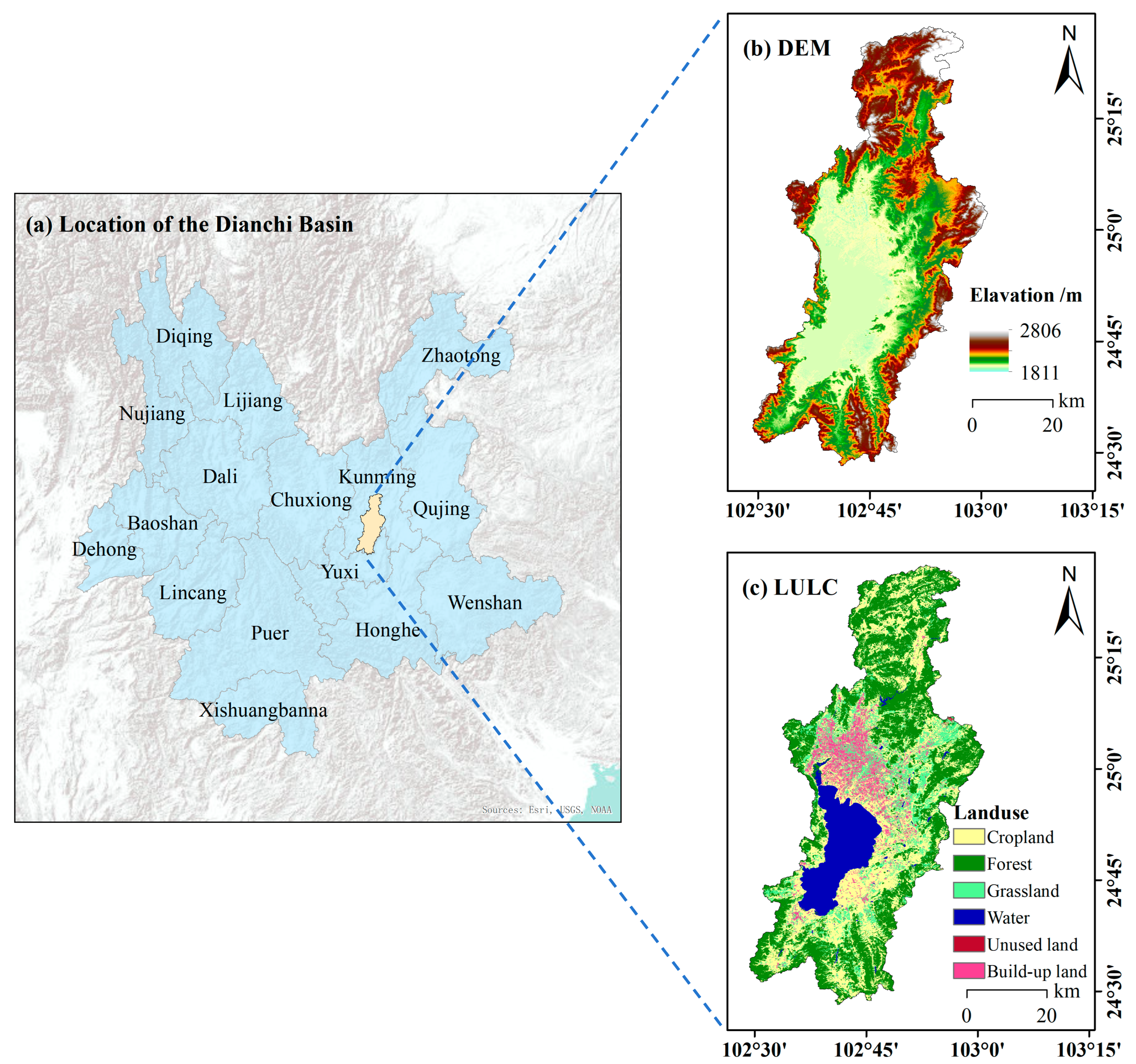
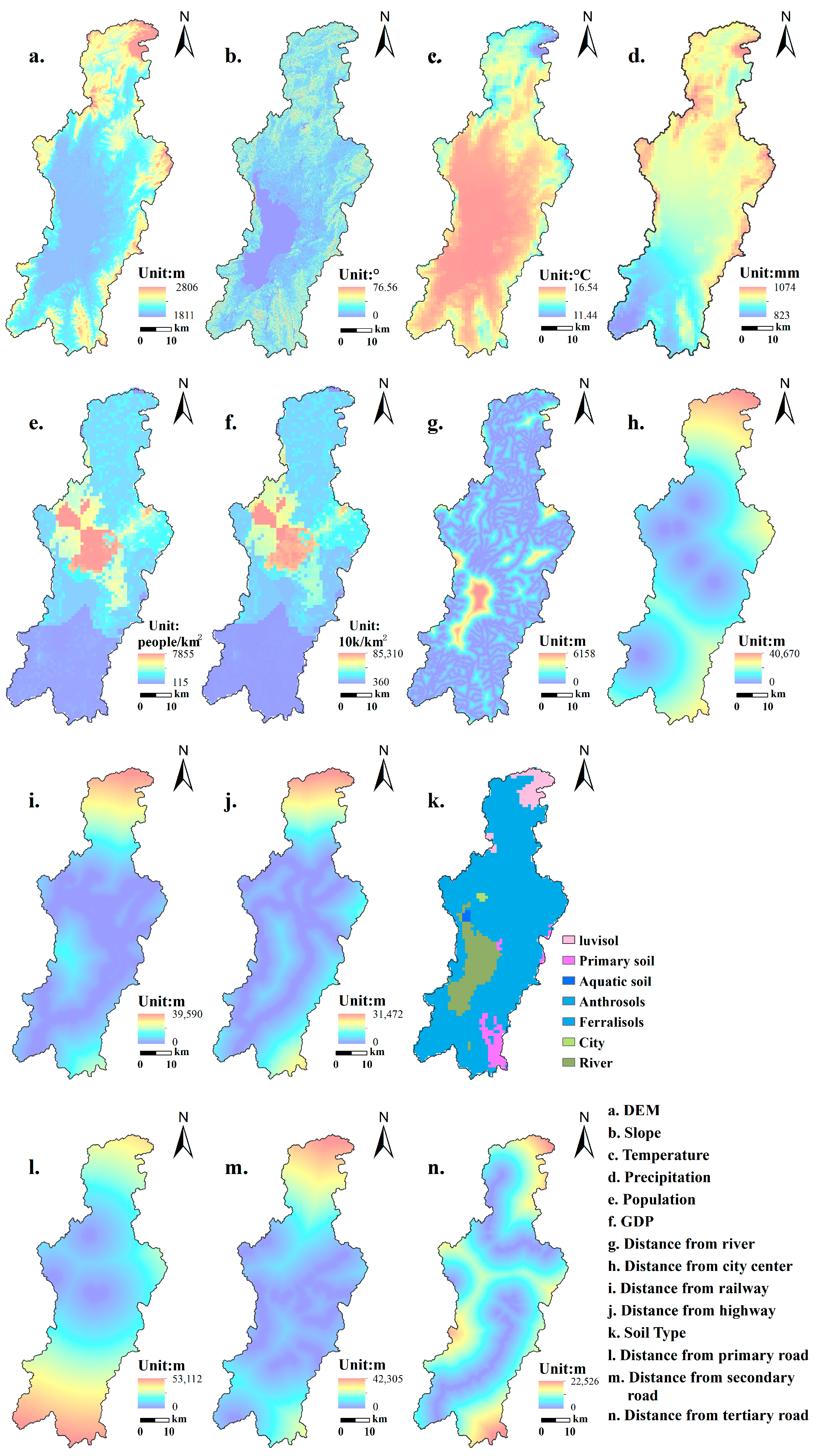
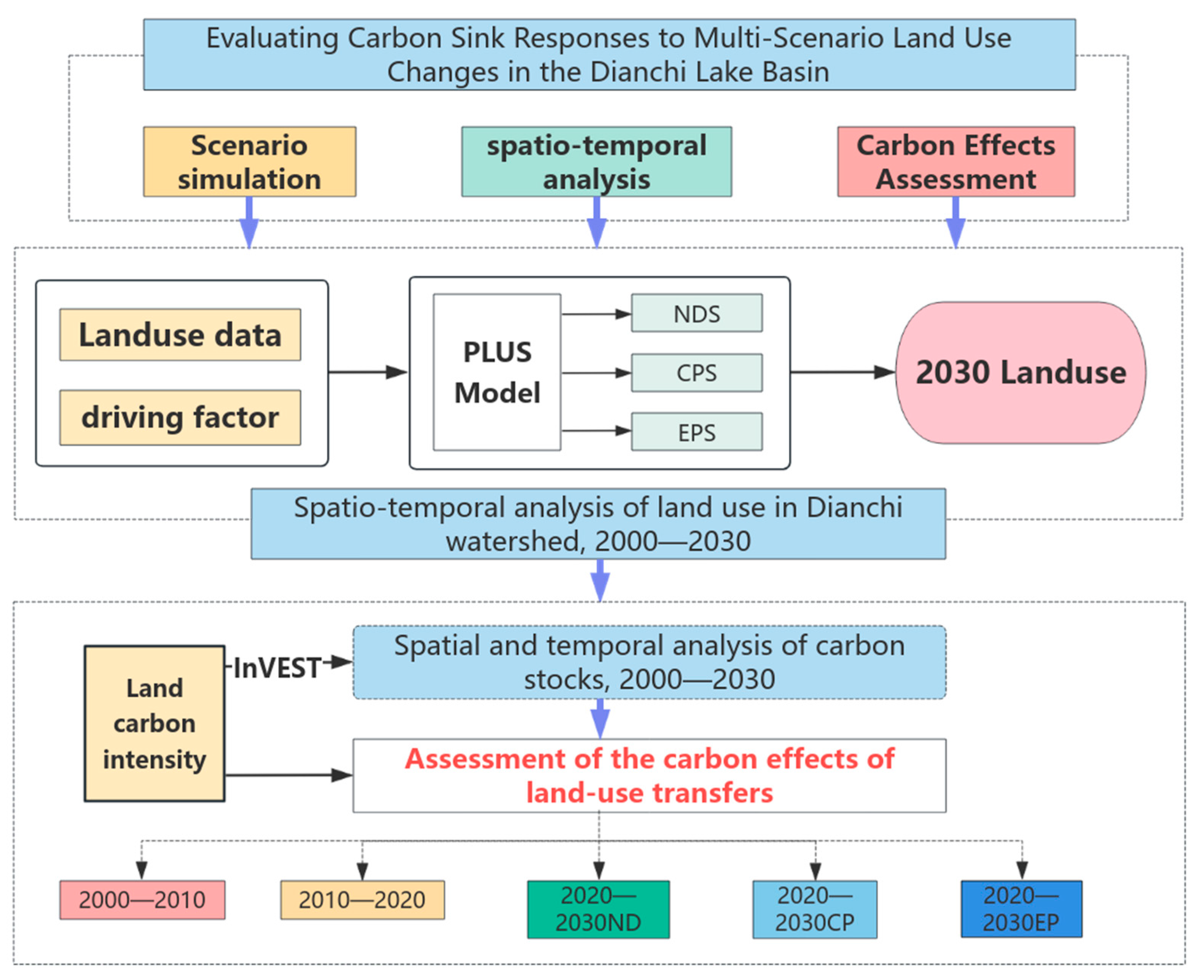
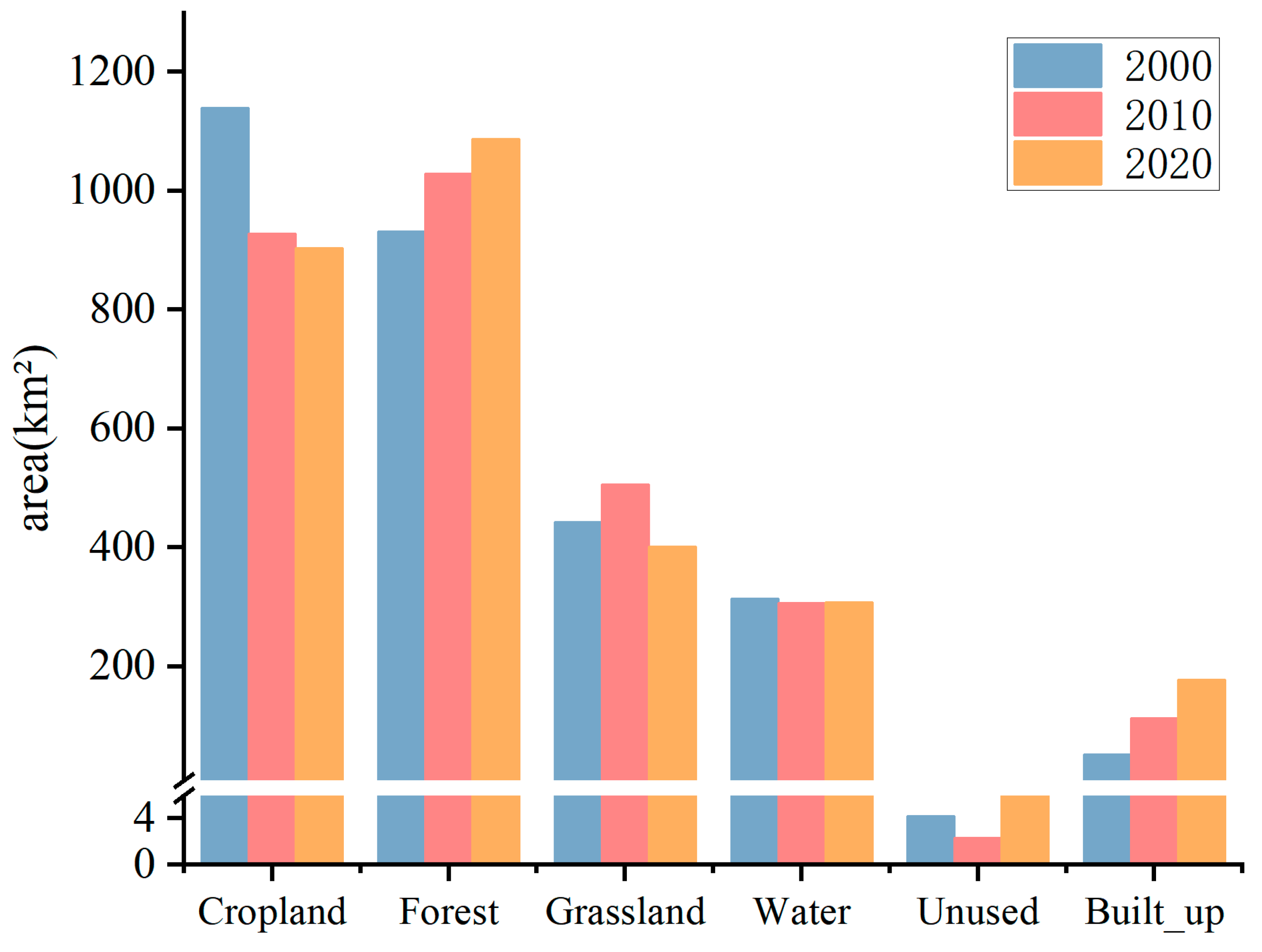
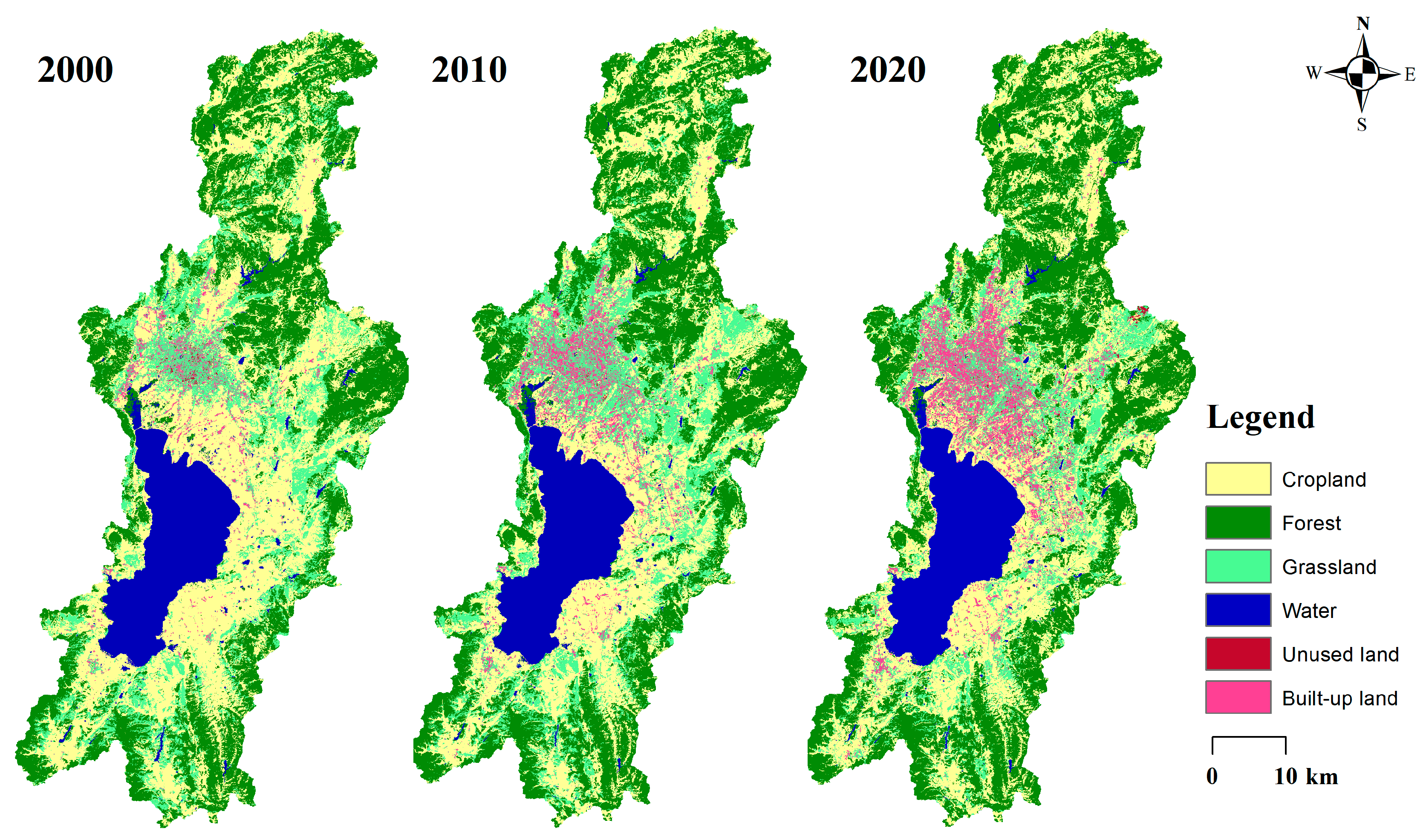

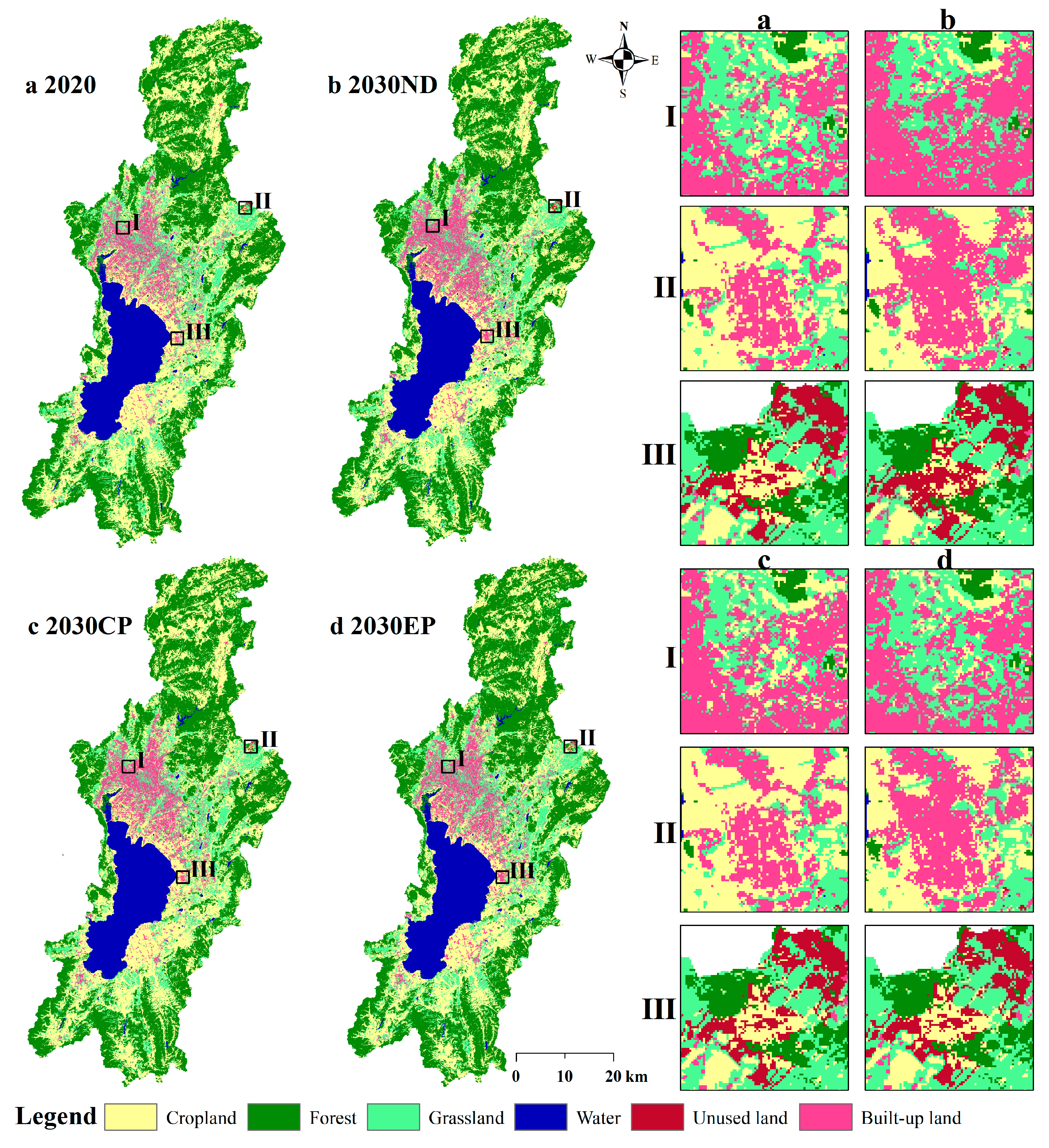
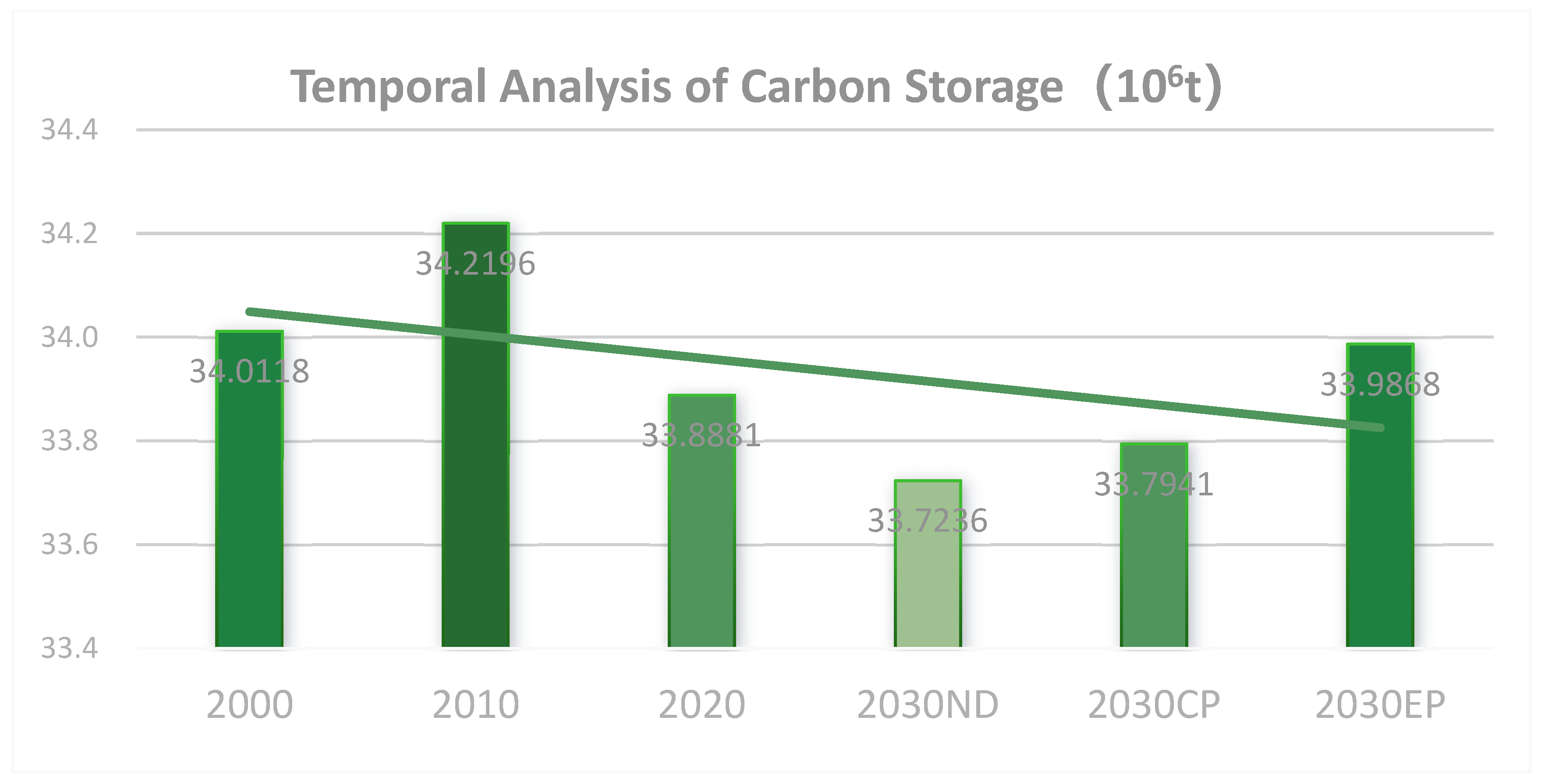
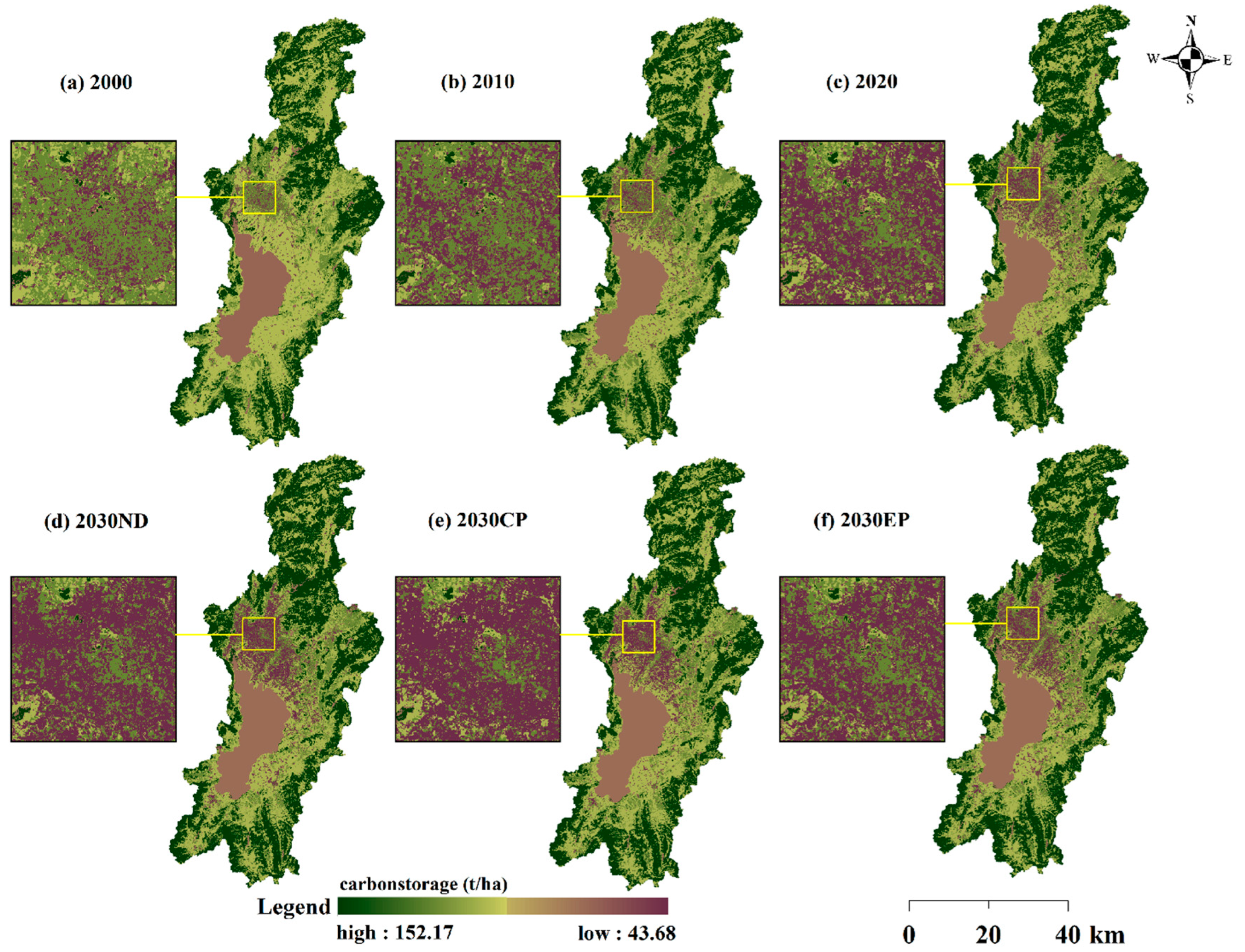

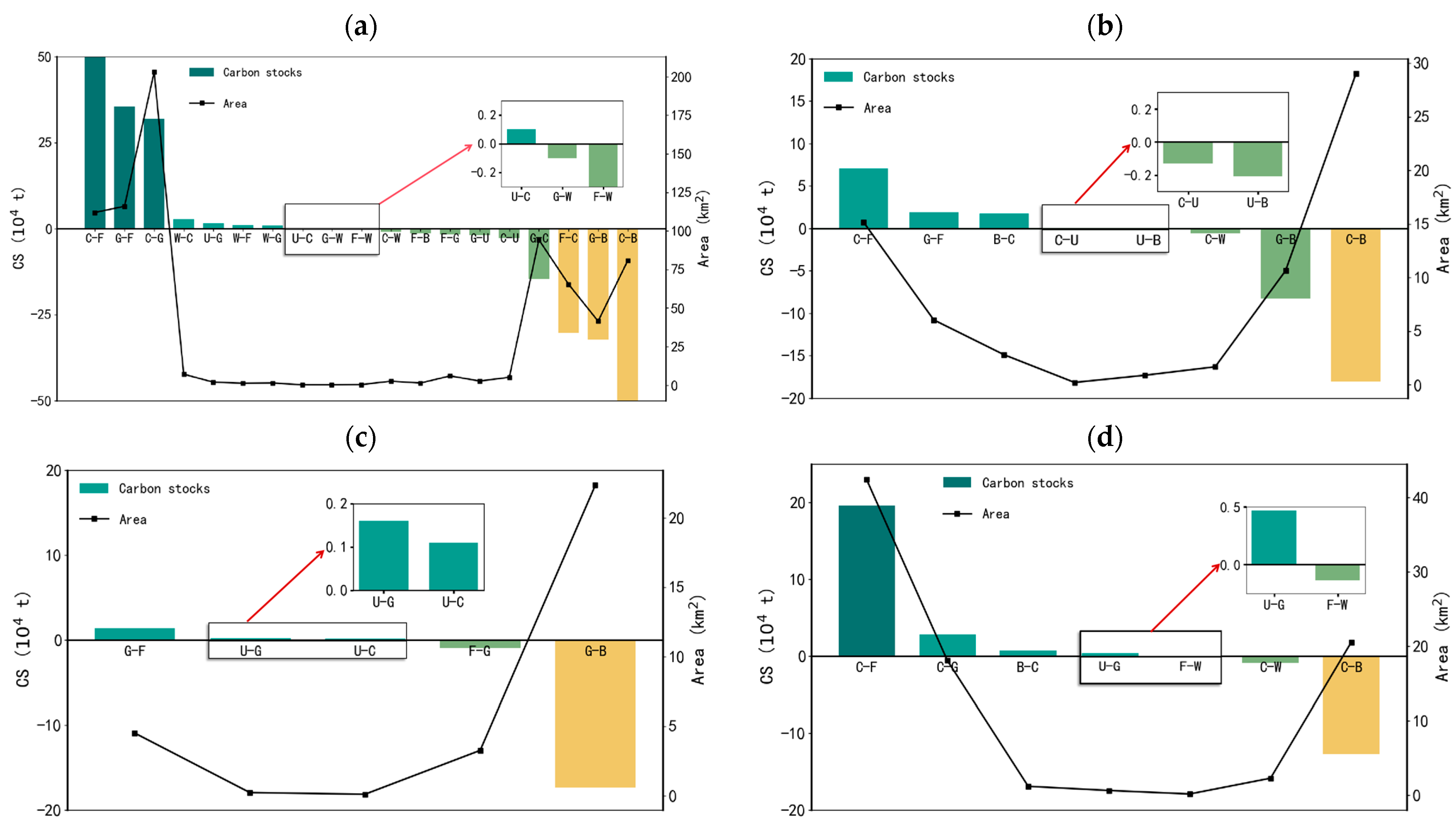
| Land Use Type | Aboveground CD | Belowground CD | Soil CD | CD of Dead Organic Matter |
|---|---|---|---|---|
| Cropland | 16.83 | 11.12 | 75.89 | 2.11 |
| Forest | 30.76 | 18.40 | 100.24 | 2.78 |
| Grassland | 14.59 | 17.50 | 87.13 | 2.42 |
| Water | 0 | 0 | 64.09 | 1.78 |
| Unused land | 7.77 | 1.55 | 34.36 | 0 |
| Built-up land | 10.57 | 2.11 | 34.45 | 0.96 |
| Natural Development Scenarios | Cropland Protection Scenarios | Ecological Protection Scenarios | ||||||||||||||||
|---|---|---|---|---|---|---|---|---|---|---|---|---|---|---|---|---|---|---|
| a | b | c | d | e | f | a | b | c | d | e | f | a | b | c | d | e | f | |
| a | 1 | 1 | 1 | 1 | 1 | 1 | 1 | 0 | 0 | 0 | 0 | 0 | 1 | 1 | 1 | 1 | 1 | 1 |
| b | 1 | 1 | 1 | 1 | 0 | 1 | 1 | 1 | 1 | 1 | 0 | 1 | 0 | 1 | 1 | 1 | 0 | 0 |
| c | 1 | 1 | 1 | 1 | 1 | 1 | 1 | 1 | 1 | 1 | 1 | 1 | 0 | 1 | 1 | 1 | 1 | 0 |
| d | 1 | 1 | 1 | 1 | 0 | 1 | 1 | 1 | 1 | 1 | 0 | 1 | 0 | 1 | 1 | 1 | 0 | 0 |
| e | 1 | 1 | 1 | 1 | 1 | 1 | 1 | 1 | 1 | 1 | 1 | 1 | 1 | 1 | 1 | 1 | 1 | 1 |
| f | 0 | 0 | 0 | 0 | 0 | 1 | 0 | 0 | 0 | 0 | 0 | 1 | 0 | 0 | 0 | 0 | 0 | 1 |
| 2000 | 2010 | 2020 | ||||
|---|---|---|---|---|---|---|
| Area | Proportion | Area | Proportion | Area | Proportion | |
| Cropland | 1139.61 | 39.49% | 927.82 | 32.15% | 903.37 | 31.31% |
| Forest | 931.38 | 32.28% | 1028.31 | 35.64% | 1087.27 | 37.68% |
| Grassland | 443.18 | 15.36% | 506.47 | 17.55% | 401.00 | 13.90% |
| Water | 314.58 | 10.90% | 307.16 | 10.64% | 307.49 | 10.66% |
| Unused land | 4.22 | 0.15% | 2.36 | 0.08% | 8.15 | 0.28% |
| Built-up land | 52.58 | 1.82% | 113.43 | 3.93% | 178.28 | 6.18% |
Disclaimer/Publisher’s Note: The statements, opinions and data contained in all publications are solely those of the individual author(s) and contributor(s) and not of MDPI and/or the editor(s). MDPI and/or the editor(s) disclaim responsibility for any injury to people or property resulting from any ideas, methods, instructions or products referred to in the content. |
© 2025 by the authors. Licensee MDPI, Basel, Switzerland. This article is an open access article distributed under the terms and conditions of the Creative Commons Attribution (CC BY) license (https://creativecommons.org/licenses/by/4.0/).
Share and Cite
Gao, Z.; Xu, Q.; Wang, S.; Ren, Q.; Li, Y. Evaluating Carbon Sink Responses to Multi-Scenario Land Use Changes in the Dianchi Lake Basin: An Integrated PLUS-InVEST Model Approach. Agriculture 2025, 15, 1286. https://doi.org/10.3390/agriculture15121286
Gao Z, Xu Q, Wang S, Ren Q, Li Y. Evaluating Carbon Sink Responses to Multi-Scenario Land Use Changes in the Dianchi Lake Basin: An Integrated PLUS-InVEST Model Approach. Agriculture. 2025; 15(12):1286. https://doi.org/10.3390/agriculture15121286
Chicago/Turabian StyleGao, Zhenheng, Quanli Xu, Shu Wang, Qihong Ren, and Youyou Li. 2025. "Evaluating Carbon Sink Responses to Multi-Scenario Land Use Changes in the Dianchi Lake Basin: An Integrated PLUS-InVEST Model Approach" Agriculture 15, no. 12: 1286. https://doi.org/10.3390/agriculture15121286
APA StyleGao, Z., Xu, Q., Wang, S., Ren, Q., & Li, Y. (2025). Evaluating Carbon Sink Responses to Multi-Scenario Land Use Changes in the Dianchi Lake Basin: An Integrated PLUS-InVEST Model Approach. Agriculture, 15(12), 1286. https://doi.org/10.3390/agriculture15121286






